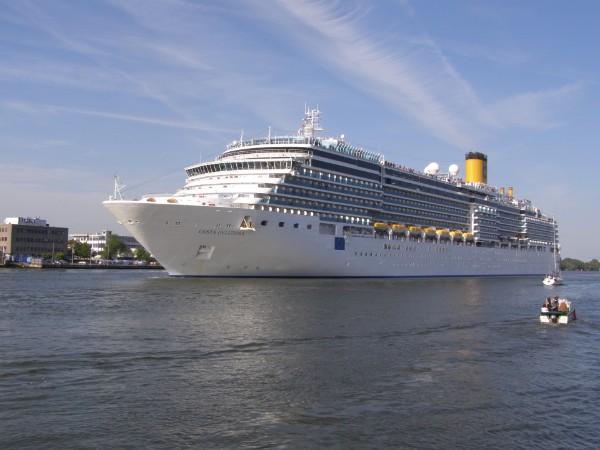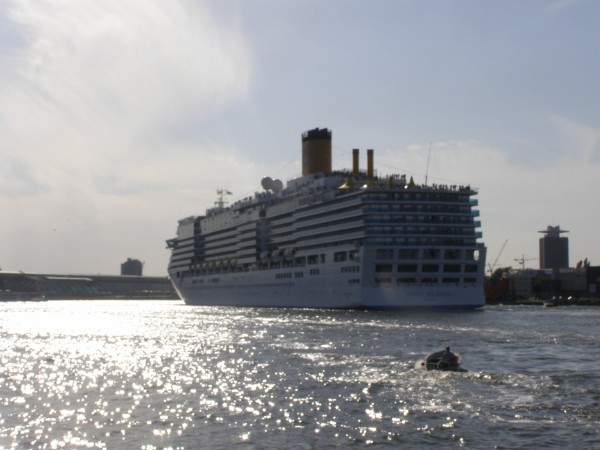Costa Deliziosa
Background

Costa Deliziosa is seen here during her departure from Amsterdam at the 25th of may in 2011.
One of the most efficient and popular shipdesigns in history, that is what you can call the 8000-class that was introduced in the end of the 1990's. The first ship built in this class was the Costa Atlantica in 1999, but the class became more-over known as the Spirit-class, after the first ship that was built for Carnival Cruise Lines in 2001, Carnival Spirit. In total six ships were built in this class and when a new class of ships was announced for Holland America Line under the work-name of 9000-class (later known as Vista-class), they were built out of the same blueprints. The Vista's became slightly larger and had two working funnels, as well as larger enginerooms as they ran on so-called CODAG systems, a combination between diesel and gas propulsion. This proved to be more environmental-friendly. In 2006, Carnival ordered a two-ship class for Costa, that was going to be a cocktail of the Spirit- and the Vista-classes, then known simply as the 8500-class. The first of the duo of ships entered service in may of 2009 under the name of Costa Luminosa and she was followed by a sister in 2010 under the name of Costa Deliziosa. Only two of these ships were built, but with all close sisters, all the girls of the combined classes can be described as one big happy family. For Cunard Line, two more enlarged versions were built as Queen Victoria and Queen Elizabeth, P&O Cruises got the Arcadia and Holland America again recieved two enlarged Vista's under the names of Nieuw Amsterdam and Eurodam.
Construction and general statistics
Like her sister, Costa Deliziosa was built at the Fincantieri wharf at Marghera, Italy. Her yardnumber was 6164. But her keel had been laid at the Fincantieri wharf at Ancona, and after the keel and the first section were completed in july 2008, this was towed to the wharf at Marghera where the ship was finished. The ship measures 92.720 tons, has a lenght of 292 meters, she is 32,30 meters wide and her draft is 8 meters. Her passenger capacity is 2828 and she sails normally at a speed of 21,6 knots, although her top speed is 23,6 knots. On the 12th of january in 2009, the ship sailed her first trials and these went smoothly so the ship could be delivered to Costa Cruises at the 27th of january in 2010.

Design
The 8500-class ships combined the proven concepts of the Spirit-class and mostly the environmental changes that had been made within the Vista-class. Together, Costa Luminosa and Costa Deliziosa became the first Italian ships and two of the first cruiseships in the world who used a system called 'cold ironing', that means that when the ships are in port, power is provided from the dockside and the engines do not need to be running, of course saving precious fuel. The ships were also designed as true Panamax-ships, so they are much more flexible in the possibilities for cruising then the larger ships that are unable to sail the Panama-canal.
Inside, the ship was of course designed by Carnival Corporations head-designer Joseph Farcus. His style is mostly glittery and loud, although mostly at the ships of Costa his designs are more suptile to attract also the European passenger. In contradiction to Costa Luminosa, Costa Deliziosa is designed with more creamy colours like caramel and browns. Also, a lot of marble and granite is used aboard, next to Murano glass and 970 La Murrina-designed lights. Aboard, the company placed several self-service screens, called 'Totems', that can be used for on-board information like restaurant-reservations, your personal on-board account or information about the daily activities. A detailed look of her interiours is shown on the next page, as I was able to tour the ship in june of 2011.
Naming ceremony
After her delivery, she sailed her maiden voyage from Savona, Italy starting at the 5th of february. During this voyage she was named in Port Rashid in the United Arab Emirates, being the first cruiseship that was ever named in the Middle East. The event coincided with the opening of the new cruise terminal in Port Rashid. Instead of a bottle of champagne, a bottle of juice was used, because of the Muslim faith of Dubai. That is also why the event was not called a christening but a naming. During the ceremony, there was a performance from Arabian horsemen and parachutists with the Costa logo at the parachute. The ship was named by Tala Dionisi, the wife of the Italian ambassador to the United Arab Emirates.

Carreer
Costa Deliziosa started cruising out of Port Rashid before she was placed in the European summerseason out of Copenhagen in 2011. On the 21st of may 2011, she had the misfortune to be broken loose from her moorings at the port of Bergen, Norway due to high winds. The ship scraped the pierside over the lenght of 50 meters, but there was no real damage done to the ship and no one was hurt. For safety, the rest of the passengers that had to board the ship were not using the gangway but were tendered onboard.


As the ship was designed to transit the Panama-canal, Costa Deliziosa also became the choice for the world-cruises undertaken by Costa, mostly sailing on 100-day voyages around the world in wintertime.
While berthed in Valencia, Spain, at the 18th of may 2014, the ship suffered a blackout for several hours when the electrical supply failed. Because of the delay that it caused, passengers were offered flights towards Genoa or Rome when they were supposed to disembark in one of those following ports. Repair work took untill may 22nd, and the ship finally arrived at the Savona cruiseterminal one day later.

